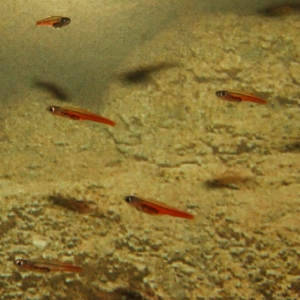Paedocypris progenetica
| Paedocypris progenetica | ||||||||||||
|---|---|---|---|---|---|---|---|---|---|---|---|---|

Paedocypris progenetica |
||||||||||||
| Systematics | ||||||||||||
|
||||||||||||
| Scientific name | ||||||||||||
| Paedocypris progenetica | ||||||||||||
| Kottelat , Britz , Tan & Witte , 2006 |
Paedocypris progenetica is the smallest known fish species in the world and wasconsidered the smallest vertebrate until the discovery of the frog species Paedophryne amauensis . Together with Paedocypris micromegethes , the species hasunique characteristics compared to other fish.
Shape and build
The smallest sexually mature female found had a length of 7.9 mm. Male animals can reach a length of almost 10 mm. The animals are pedomorphic . This means that despite sexual maturity they show many characteristics of a larval stage . The fish are almost transparent and there is no bony skull roof . The rudimentarily developed skull therefore reveals the brain and you can also see the spine .
All characteristics of sexual maturity are developed as typical adult characteristics. The females develop mature eggs. The males have strongly modified, muscular pelvic fins compared to their body size, and a keratinized plate in front of the pelvic girdle . This suggests a specialized mating technique. It is believed that these fins are used for reproduction and represent a kind of holding device for the female. Also shed and the sense organs of the lateral line are completely absent.
habitat
The occurrence of Paedocypris progenetica is limited to the rare, black-water peat bog forests of the Indonesian islands of Sumatra and Bintan . The trees in these forests are rooted in soft layers of peat meters thick, over which strongly acidic water forms. The species prefers the deeper, deeper, slow-flowing, cooler layers of water with a pH value of 3, which is about 100 times the acid concentration of normal rainwater or that of vinegar . One finds Paedocypris progenetica only in shady places in primary or secondary forest.
Way of life
The species feeds on plankton such as rotifers ( Rotifera ) and Cladocera with a size of 60 to 500 μm. The females carry around 50 to 60 eggs at various stages of maturity in their ovaries . Ripe eggs are 0.3 mm in diameter. The simultaneous occurrence of immature and ripe eggs suggests individual egg laying (as with Cyclothone microdon ).
classification
Together with the newly discovered and only slightly larger species Paedocypris micromegethes from Sarawak , Paedocypris progenetica establishes its own genus of carp and whitefish (Cyprinidae). Due to a number of common properties include both types of the group of dwarfed fish (miniature fish).
Discovery story
The species was discovered and identified in a systematic inventory of the fauna of Asia commissioned by the University of Singapore by Maurice Kottelat and Tan Heok Hui from the Raffles Museum of Biodiversity Research in Singapore in 1996. The osteology was of Ralf Britz examined by the Natural History Museum in London. Kai-Erik Witte was one of the authors of the original description .
threat
The forests and wetlands of Indonesia and Malaysia are increasingly being decimated by the expansion of agriculture. In addition, there are forest fires that are difficult to extinguish . This destruction of the animal's habitat endangers the survival of not only this species and thus the possibility of further research.
literature
- M. Kottelat, R. Britz, HH Tan, K.-E. Witte: Paedocypris, a new genus of Southeast Asian cyprinid fish with a remarkable sexual dimorphism, comprises the world's smallest vertebrate. In: Proceedings of the Royal Society. Volume 273, Number 1589, April 22, 2006, doi: 10.1098 / rspb.2005.3419 .
- RMBR: So which is the smallest species of fish in the world? (Part II) February 4, 2006. (Report by the Raffles Museum from Singapore with numerous photos)
- K.-E. Witte: The smallest vertebrates in the world? - Paedocypris species have much more to offer. In: Aquaristik. Current freshwater practice. No. 3, 2006, ISSN 1863-1282 .
Web links
- Paedocypris progenetica on Fishbase.org (English)
Individual evidence
- ^ EN Rittmeyer, A. Allison, MC Gründler, DK Thompson, CC Austin: Ecological Guild Evolution and the Discovery of the World's Smallest Vertebrate. In: PLoS ONE. Volume 7, No. 1, 2012, p. E29797. doi: 10.1371 / journal.pone.0029797